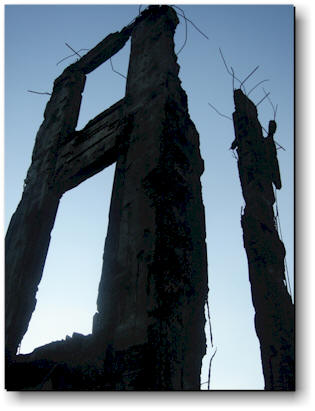From the MANILA
BULLETIN of 28
December 2006
Corregidor ruins
are being saved
not desecrated
By Beth Day
Romulo
AS president
of the
Corregidor
Foundation, I,
and our
supportive
friends from the
Fil-Am Memorial
Endowment (FAME)
have been trying
desperately for
a dozen years or
more to find the
necessary
funding to shore
up the walls of
the military
barracks
buildings on
Corregidor
Island before
they are lost to
typhoons, or
merely collapse
from age and
lack of support.
We have
approached
UNESCO three
times to no
avail. We have
made private
personal appeals
to government
agencies here
and in the
United States,
to veterans
groups and
individuals with
influence to no
avail. We have
taken architects
and experts to
the sites and
received their
recommendations
but no source of
funding
materialized.
Meanwhile, we
lose a few more
sections of
hallowed walls
with each
typhoon.
 Finally this
past year we
succeeded in
interesting the
local government
and the
Department of
Budget released
some funds
through the
National
Historical
Institute to
clean up
Middleside
Barracks which
was hardest hit
in the recent
typhoons, and
shore up the
walls so they
will not be lost
to posterity.
When the work is
finished,
Middleside will
be clean and
accessible as
Topside’s
Milelong
Barracks which
stands in stark
grandeur with no
trees or
underbrush
obscuring it.
Finally this
past year we
succeeded in
interesting the
local government
and the
Department of
Budget released
some funds
through the
National
Historical
Institute to
clean up
Middleside
Barracks which
was hardest hit
in the recent
typhoons, and
shore up the
walls so they
will not be lost
to posterity.
When the work is
finished,
Middleside will
be clean and
accessible as
Topside’s
Milelong
Barracks which
stands in stark
grandeur with no
trees or
underbrush
obscuring it.
Unfortunately
some well
meaning people,
unfamiliar with
the cleanup
project, have
mounted a
campaign on the
Internet to stop
the rescue work
which they
consider a
"desecration" of
a historic site.
This
misperception
began when
workmen were
seen using
acetylene
torches to cut
dangerous,
dangling wires,
with slabs of
concrete hanging
from them that
might well have
fallen on
tourists heads.
The workmen also
used the torches
to cut newly
exposed ends of
steel bars,
considered
equally
dangerous.
Workers were
also, according
to the National
Historical
Institute plan,
cutting trees
within a safety
perimeter of the
walls so that if
they fall,
during typhoons,
they won’t bring
down more
sections of
walls with them,
which happened
recently when
five trees were
uprooted, taking
down sections of
walls as they
fell. One huge
tree, whose
roots are
entwined within
the structure of
the barracks was
simply topped
rather than
disturb its
roots and the
trees lining the
road were not
touched.
Phase One of the
clean-up job was
simply cleaning
out the typhoon
damage, removing
dangerous debris
and cutting
trees close to
the walls that
threatened
further damage.
Phase two will
include
deepening a
drainage ditch
to prevent soil
erosion and the
flooding of the
ground floor of
the buildings,
putting
stainless steel
plates to cover
manholes, and a
partial shoring
up of the
weakest posts,
walls, floors
and ceilings
with steel bars
that lie flush
with interior
construction.
Phase Three will
complete the
shoring up and
support of the
existing walls.
With the removal
of trees and
brush that
obscured the
actual front of
the building,
tourists will
now have a view
of the
architectural
design which was
denied them when
they passed in
back of the
barracks.
What has been
and is being
done is
certainly no
desecration of a
historic site
but simply
technical
intervention to
prevent further
deterioration
and an attempt
to preserve what
we have left of
the ruins.
I would have
appreciated if
it our well
meaning friends
who are trying
to stop the
rescue of
Middleside
Barracks would
have started
their "Save
Corregidor"
campaign when we
needed it, and
had helped with
the funds. With
this cleanup and
shoring up
operation,
Middleside
Barracks will
look like the
memorable
Topside Milelong
barracks which
escaped collapse
thus far because
there are no
trees near it.
Eventually, if
funding can be
found, we hope
to shore up and
support all the
remaining
structures on
Corregidor,
including the
hospital and the
cinema.
Middleside
Barracks is an
emergency rescue
operation.
Beth Day Romulo
